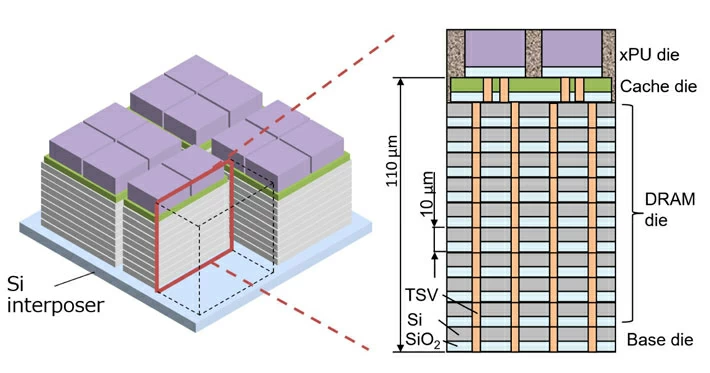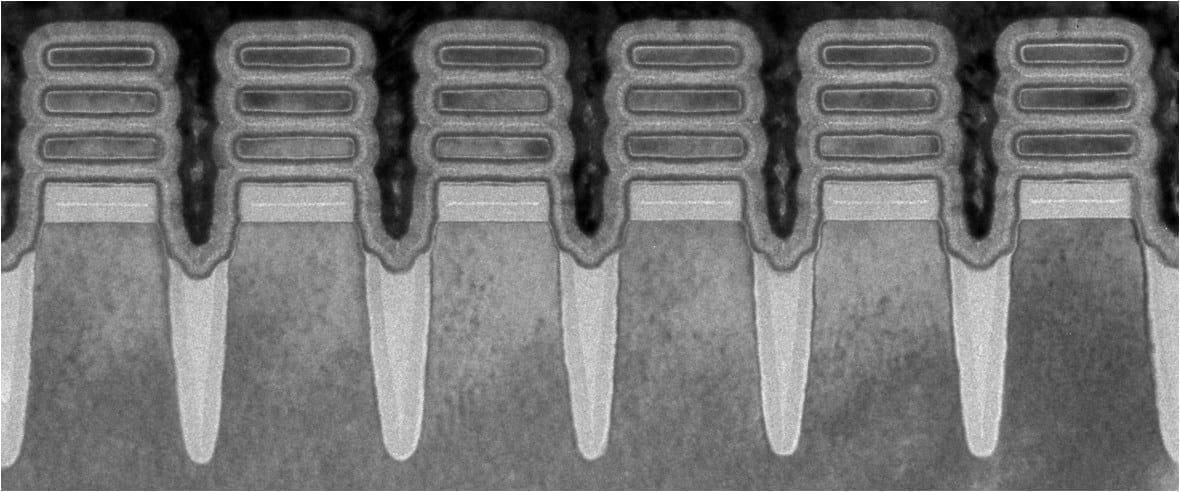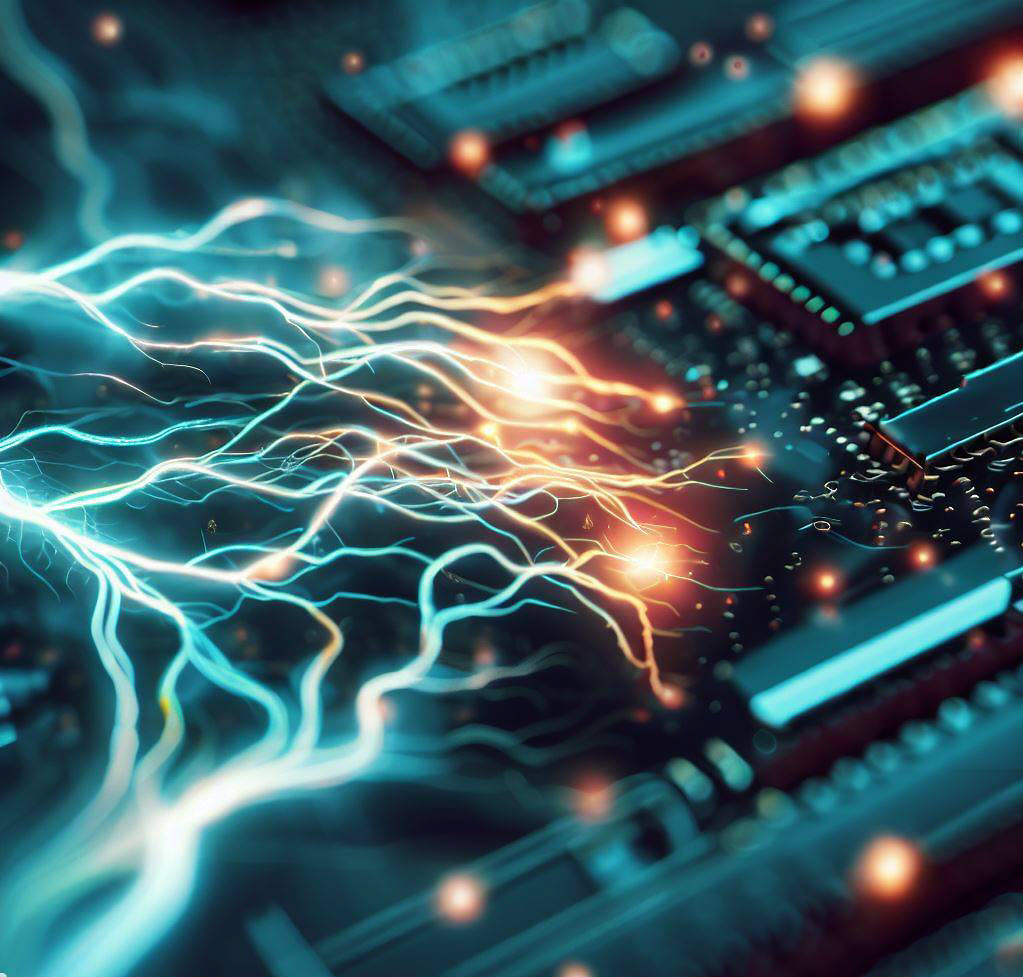
Figure 1. Structural diagram of BBCube 3D
The proposed technology uses a stacked design where processing units (xPU) sit atop multiple interconnected memory layers (DRAM). By replacing wires with through-silicon vias (TSVs), the lengths of the connections can be shortened, leading to better overall electrical performance.
Implementing CPU/GPU and Memory in a Hybrid 3D Approach
A technology for the three-dimensional integration of processing units and memory, as reported by researchers from Tokyo Tech, has achieved the highest attainable performance in the whole world, paving the way to faster and more efficient computing. Named “BBCube 3D,” this innovative stacked architecture achieves higher data bandwidths than state-of-the-art memory technologies, while also minimizing the energy needed for bit access.
In the present digital age, engineers and researchers keep coming up with new computer-assisted technologies that require higher data bandwidths between the processing units (or PUs, such as GPUs and CPUs) and memory chips. Some examples of modern bandwidth-extensive applications include artificial intelligence, molecular simulations, climate prediction, and genetic analysis.
However, to increase the data bandwidth, one must either add more wires between the PUs and the memory, or increase the data rate. The first approach is difficult to implement in practice because transmission between the above-mentioned components usually happens in two dimensions, making the addition of more wires tricky. On the other hand, increasing data rate requires increasing the energy needed to access a bit each time, called the ‘bit access energy’, which is also challenging.
Fortunately, a team of researchers at Tokyo Institute of Technology (Tokyo Tech) in Japan may now have found a viable solution to this problem. In a recent IEEE 2023 Symposium on VLSI Technology and Circuits study, Prof. Takayuki Ohba and colleagues have proposed a technology called “Bumpless Build Cube 3D” or BBCube 3D. This technology holds the potential to resolve the above-mentioned issues for better integration between PUs and dynamic random access memory (DRAM).
As the name suggests, the most notable aspect of BBCube 3D is the realization of connections between PUs and DRAMs in three dimensions, instead of two dimensions (as seen in Figure 1 above). The team was able to achieve this feat by using an innovative stacked structure in which the PU dies sit atop multiple layers of DRAM, all interconnected via through-silicon vias (TSVs).
BBCube 3D’s overall compact architecture, the lack of typical solder microbumps, and the use of TSVs in place of longer wires, together contribute to low parasitic capacitance and low resistance. This improves the electrical performance of the device on various fronts.
Furthermore, the researchers implemented an innovative strategy involving four-phase shielded input/outputs (IOs) to make the BBCube 3D more resistant to noise. They adjusted the timing of adjacent IO lines such that they are always out of phase with each other, meaning that they never change values simultaneously (Figure 2). This reduces crosstalk noise and makes the device operation more robust.
The team evaluated the speed of their proposed architecture and compared it to that of two state-of-the-art memory technologies: DDR5 and HBM2E. “The BBCube 3D has the potential to achieve a bandwidth of 1.6 terabytes per second, which is 30 times higher than DDR5 and four times higher than HBM2E,” says Prof. Ohba, while explaining the results of their experiment.
Moreover, BBCube 3D also represents a major breakthrough in terms of the bit access energy. “Due to the BBCube’s low thermal resistance and low impedance, the thermal management and power supply issues typical of 3D integration can be relieved,” explains Prof. Ohba, “As a result, the proposed technology could reach a remarkable bandwidth with a bit access energy that is 1/20th and 1/5th of DDR5 and HBM2E, respectively.”
We surely hope that the BBCube 3D paves the way to faster and more efficient computing, in turn, boosting the progress of numerous fields.
Original Article: BBCube 3D: A Breakthrough in Semiconductor Integration and Data Transmission
More from: Tokyo Institute of Technology
The Latest Updates from Bing News
Go deeper with Bing News on:
BBCube 3D
- The Best 3D Printers for 2024
More affordable than ever, 3D printers are booming for personal, professional, and educational use. Here's everything to know before you buy one, along with the top models from our hands-on testing.
- Innolux takes significant strides in 3D chip packaging
Innolux signed an agreement with Japan-based Tech Extension Co. (TEX) and Tech Extension Taiwan Co. (TEX-T) to introduce next-generation 3D packaging technologies based on Bumpless Build Cube (BBCube) ...
- 3d Printer hacks
A common way to visualize that a 3D printer’s extruder motor — which feeds the filament into the hot end — is moving is to attach a small indicator to the exposed end of the motor’s shaft.
- Best Budget 3D Printer of 2024
While his main areas of expertise are maker tools -- 3D printers, vinyl cutters, paper printers, and laser cutters -- he also loves to play board games and tabletop RPGs. Expertise 3D printers ...
- Best 3D modeling software of 2024
If you're all about bringing ideas to life, the best 3D modeling software is essential. Widely used across the automotive industry, film-making, engineering, gaming, product design, and for 3D ...
Go deeper with Bing News on:
Faster computing
- Better Quantum Computing Stock: IBM vs. IonQ
IBM is growing slower than IonQ and hasn't generated significant revenue from its quantum computing systems yet. However, it's firmly profitable and supporting the future growth of its quantum ...
- Researcher: Climate models can run for months on supercomputers—but my new algorithm can make them ten times faster
Climate models are some of the most complex pieces of software ever written, able to simulate a vast number of different parts of the overall system, such as the atmosphere or ocean. Many have been ...
- Quantum computing breakthroughs draw investment back to sector
A series of research breakthroughs, starting with Google last year, has brought major advances in error correction years earlier than most expected. Research results from Harvard University and Boston ...
- How to see what CPU your computer has and how fast it is
Curious about the brain of your computer? The Central Processing Unit (CPU) is crucial as it defines your computer's capabilities and how efficiently it ...
- Act fast! This RTX 4060 gaming laptop just got $516 off in epic deal
Right now, the Legion Pro 5i with Nvidia RTX 4060 GPU is on sale at Lenovo. The official store has slashed the regular retail price of $,1,829 down to just $1,313, making for a drool-worthy $515 ...










